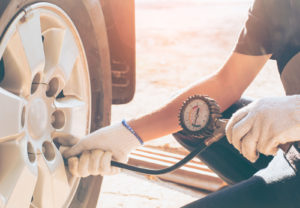What Should Your Tire Pressure Be?
July 8th, 2020 by Fix Auto USA

Ensuring that your tire pressure is correct is one of your most important responsibilities as a driver. Underinflated tires can put you and your passengers at risk for tire failure or blowout.
According to the National Highway Traffic Safety Administration, 562 people died in tire-related accidents in 2022. The culprit in most of these accidents? Underinflated tires.
Not maintaining correct tire pressure also affects the size of your wallet because underinflated tires cause cars to run inefficiently, meaning more frequent trips to the gas station. But what should your tire pressure be? Let’s explore that question.
How Much Air Should Be in a Car Tire?
So we can all agree that it is essential to keep your tires inflated.
But what PSI should your tires be? That is the question!
The recommended tire pressure is typically between 30 and 35 PSI air pressure, or pounds per square inch, assuming your tires are cold.
You can usually find the manufacturer’s recommended tire pressure on a sticker inside the driver’s door or inside the owner’s manual.
If underinflating tires carry risks, so does overinflating them. For starters, tires that are inflated too much don’t last as long and are less safe because of reduced traction. Overinflating tires makes them rigid, accelerates wear, and also makes the ride feel stiff.
Your tire pressure monitoring system (TPMS) is a great tool that shows a flashing light indicating that one of your tires is underinflated. However, don’t over-rely on your TPMS. It’s best to manually monitor your car tire air pressure yourself and think of TPMS as your backup support.
How to Check Your Tire Pressure
TPMS is a great tool, but it may not always be accurate—and, depending on your model, it may only alert you to a problem without the context needed to fix it. Here are the steps to check your tire pressure on your own.
1. Determine Your Normal Tire Pressure
You’ll find this information in one of three places:
- Driver’s side door: A sticker on your door usually lists a great deal of information, including recommended tire pressure, VIN, tire size, rim size, and more.
- Owner’s manual: Do you know where your owner’s manual is? That’s the question for a lot of drivers, especially if you bought a used vehicle! But if you get your hands on it, it should be easy to find your tire pressure.
- Glove compartment: There may be a sticker inside the glove box that lists the recommended PSI.
What about the tire pressure listed on the tire itself? If you check that, you’ll almost certainly see a discrepancy between what’s listed there and the spots we suggested. That’s because the tire lists the maximum PSI, but we’re interested in the recommended tire pressure.
2. Start with Cold Tires
PSI increases as you drive around and warm the tires up, making it difficult to get a consistent reading. Check your tire pressure first thing in the morning or after your car has been sitting for a while to get an accurate, consistent measurement.
3. Get a Tire Gauge
You’ve got a few options here. First of all, you can purchase a tire gauge of your own. You’ll find a range of choices, including manual gauges and digital ones. The manual models tend to be a little cheaper, but the difference isn’t significant.
If you go the at-home route, you’ll also need a tire pump or air compressor to fill your tires to the proper level.
Your other option is to use an automatic air system that you can find at a local gas station or retailer. This may cost a couple of bucks for each fill-up, but many of these units include a digital gauge so you can measure and fill your tires at the same time.
4. Remove the Valve Cap
When you’re ready to go, it’s time to remove your valve cap. If you’re working on multiple tires at a timed compressor you paid to use, it can be valuable to have a partner who unscrews and replaces valve caps while you see to each tire before your time runs out.
5. Attach the Tire Gauge to the Valve
If you’re using an automatic system that checks your pressure and fills it to the PSI you specified, you should input your normal tire pressure before hooking it up. It will measure your PSI and then automatically start filling until you reach the proper pressure.
If you’re using a separate gauge, you’ll get a reading that indicates PSI. A digital gauge is pretty self-explanatory, but you might need to consult the instructions to read a manual gauge. Some are more intuitive than others.
6. Adjust Tire Pressure and Measure Again
If the tire is above the recommended PSI, let some air out. If you’re below the proper tire pressure, add air.
As you gain experience, you may get a feel for how quickly your tire pressure changes, which will help you be more precise. But before you get to that point, it may take some trial and error—and adding and releasing air—to get the PSI where you want it.
Keep adjusting until your gauge gives you the result you want.
When’s the Best Time to Check Your Car Tire Air Pressure?
The best approach is to have a routine where you remember to check your air pressure every time you fill up with gas. Tires typically lose one pound of pressure per month. At the very least, you should check it every 30 days.
How to Maintain Tire Pressure
Now it’s just a matter of keeping an eye on your tire pressure, checking it regularly, and making adjustments as necessary. It’s a pretty straightforward process, especially once you get the hang of it.
Even if you prefer the convenience of paid air compressors, investing in an inexpensive tire gauge that you keep in your car makes a lot of sense for most drivers. That will be the easiest way to check it when you fill up as we recommended above.
While we’re at it, here’s a reminder not to neglect your spare tire. Check its air pressure from time to time, because the last thing you want when you’re in a bind is an underinflated spare tire. Also, spare tires tend to have higher pressure recommendations than regular tires, so again, check your owner’s manual.
Turn to Fix Auto for Your Auto Needs
Monitoring your car tire air pressure on an ongoing basis can extend the life of your tires and significantly reduce the chance of getting a flat tire. Monitor your tires for wear and be proactive about rotating them and maintaining their correct tire pressure. Keep all of your tires, including your spare, properly inflated based on your vehicle manufacturer’s recommended psi air pressure.
Need a little help? That’s what we’re here for. Contact Fix Auto USA for expert advice and to keep your vehicle in top condition.
The next time you need some automobile assistance, let us show you why we’re trusted by so many satisfied customers. Discover the services we offer and find the nearest location.
Be safe out there.
This blog post was contributed by Fix Auto Normal Heights, a leading industry expert and collision repair shop servicing customers in Normal Heights and San Diego area.
Welcome to
Fix Auto USA
We are the premier independent body shop network delivering world-class customer service and high-quality collision repairs across the U.S.
Learn About Us





